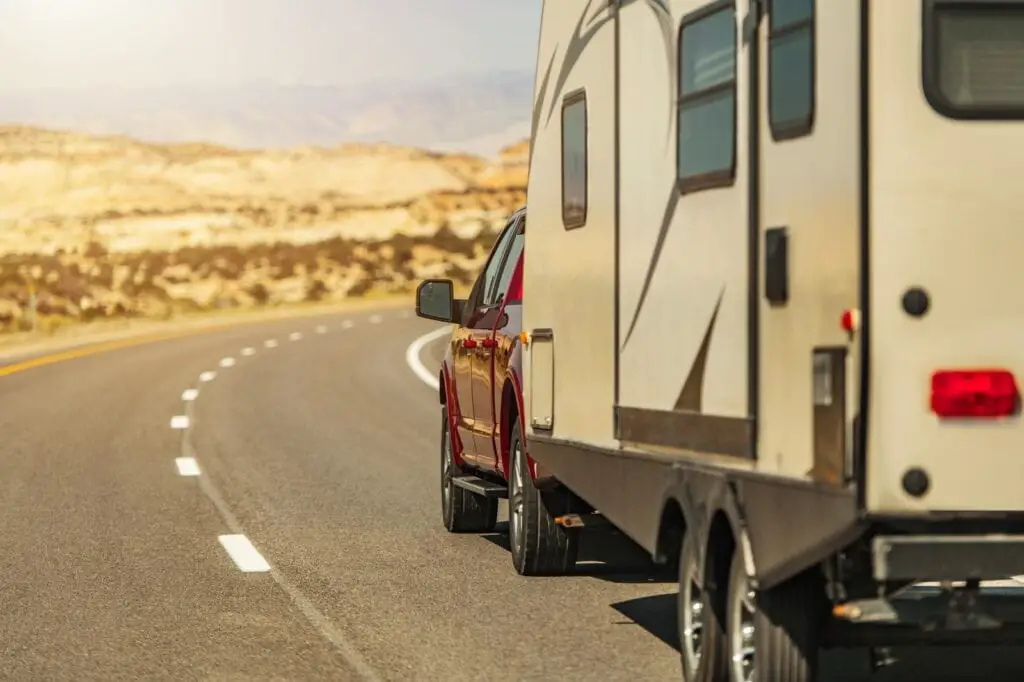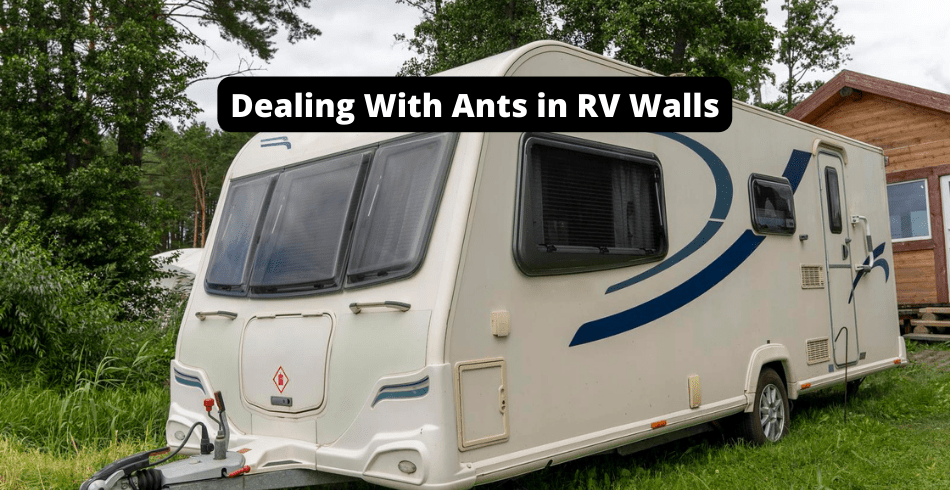Similar to house walls, the walls of your RV are a favorite location for ant habitation.
Noticing just one or two ants in your RV wall indicates a possible infestation.
There are two key moments when ants can infest your RV’s walls, first, during camping sessions or tailgating. Second, when the camper is stored away for long periods after a camping season.
In these two “ant problem” situations, understanding why ants can make their way into the RV walls helps you reverse engineer the best way to stop the ant infestation.
Ants crawl in and out of RVs, looking for food and water or returning to the nest.
Seeing ants in your RV walls implies a failure of preventative pest control measures, and it’s also indicative of structural weaknesses enabling the ants to find their way to the RV walls.

What’s the fastest way to get rid of ants in RV walls?
Ants are a nuisance when crawling in and out of your RV walls in those relaxing camping moments.
On such occasions, it’s tempting to reach for the closest pest spray to kill the ants, right?
Wrong!
Before taking any action to get rid of ants in your camper’s walls, there are a few things to remember.
Presence of food or water
Most ants types you see in your camper are attracted to food and water.
Noticing ants in an RV wall likely implies they’ve located food, waste crumbs, or a water source.
If you see a line of ants, the RV’s wall trail links a food source and a nest – start there.
Before acting, identify the species.
Different ant types require different control approaches.
The most typical species, black ants, sugar ants, and pharaoh ants, seen on RV walls, are foraging for food.
Identify the materials your RV walls are made from
The interior finishes of most RV walls are made from wood.
Popular finishes are plywood, Medium Density Fiberboard (MDF), and wood paneling.
As mentioned above, most ants in your RV walls are after food or water.
But carpenter ants attack your RV’s moist or damaged wooden walls, not for food but to make nests.
Remember, you can rid your RV wall of ants by preventing an ant attack before it happens.
If you are facing an ant infestation already, choose between natural or chemical control options.
With this understanding, let’s explore six ways to tackle ants in your RV walls.
Clean the RV walls
Ants are skillful food hunters with sophisticated smelling capabilities.
They are attracted to dirty RV walls with traces or stains of food on them.
Improperly stored food or spillages inside a camper’s wall cabinets attract ants.

Thoroughly clean the walls after preparing and eating food inside your RV.
Try not to litter your old food around your camper; this has been known to attract ants.
Instead, tie it up in a bag and throw it out at least 30 yards away from your camper.
Add substances like vinegar, industrial rubbing compounds, or soap to the dishwater and waste bags.
The chemicals in these detergents repel ants.
Ants forage on plants for sugars, plant sap, and water and will easily jump onto your camper from plants if they smell food in it.
Park your RV away from shrubs and tree branches to prevent ants from quickly reaching the walls from these sources.
Keep your food tightly sealed inside your camper in airtight containers before storing it in your wall cabinets.
References:
https://extension.usu.edu/pests/schoolipm/files/pest-id-handbook/Ants_2012_IPM_Manual.pdf
Apply diatomaceous earth to your RV walls
Diatomaceous earth powder is a drying agent that desiccates the ant’s body (it kills them).
Since it only works when it is in direct contact with the ant, you need to expose the ants to the diatomaceous earth directly.
Once you’ve identified the ant trails, sprinkle some on them along their path.
[amazon box=”B072J8Z28F”]Ants may access the camper’s walls via the RV’s stabilizer jack.
Apply diatomaceous earth on and around it if you notice the ant’s path.
You can also mix the food-grade diatomaceous earth with sugar or honey and feed it to the ants, which will kill them.
This will attract ants in the short term, so be cautious about this approach if you’re going to be around the camper.
Diatomaceous earth also kills carpenter ants.
Apply the powder on their trails on the wall, voids, cracks, and crevices.
Once you locate the nest’s entry hole, pump diatomaceous earth dust into the nest.
Spray chemicals to control carpenter ants
Getting rid of carpenter ants at home or in an RV wall is no easy task.
As mentioned earlier, these ants do not invade RV walls for food.
Poorly maintained or damaged wooden RV walls are perfect for a carpenter ant problem.
These species burrow into wooden RV walls to make nests. A carpenter ant colony thrives in galleries curved inside the wood.
By making nests inside the RV walls, carpenter ants are more than just a nuisance. The structural damage they cause to the RV walls decreases the value of the camper and the RV’s life.
The first step is to identify the nest’ entry holes. Trail one ant to the hole through which it disappears into the wood.
Inspect suspect areas at night when these ants are most active.

Once you locate the nest’s entry, pumping the chemicals through these holes is the best way to take full advantage of the chemicals.
The aim is to push the killer carpenter ant spray to the queen’s chambers.
It’s not enough to kill the visible ants, and only by killing the queen will the entire colony be eradicated.
Carpenter ants are not susceptible to standard baits that kill ants, Ordinary baits don’t work.
Why?
These ants have primary and satellite nests, with workers traveling between both.
To trap carpenter ants with food, use granular baits indicated specifically for carpenter ants.
[amazon box=”B003EAP02G”]After identifying their paths, place granular ant bait around, near, or under your camper.
Also, place some of it near nest entry points and identify ant trails.
Go for bait with a prolonged effect to keep carpenter ants from coming back.
References:
https://njaes.rutgers.edu/FS1101/
Use sugar baits to get rid of black and sugar ants.
Black ants and most common sugar ants easily fall for ant bait.
Remember that sugar ants are an encompassing term generally used to refer to different types of ants that crave sugars.
Black ants are tiny and invade sugary and oily foods, walk short distances to food and water sources, and they’re preyed on by some insects and ants.
They make nests in your RV’s wall spaces to overcome these disadvantages, preferring moist or abandoned sections.
Therefore, your camper’s wall is ideal for black ants’ nests. The good thing is these ants, and most sugar ants, are attracted to sugar baits.
Mix sugar with borax, baking soda, or cornmeal to eliminate them.
[amazon box=”B00K1JFC0S”]The workers eat this mixture and carry it back to the nest located in the camper’s wall.
The ants cannot digest these substances, which kills them together with members of the colony that feeds on them.
References:
https://www.ctahr.hawaii.edu/uhmg/WestHI/downloads/Sugar-Boric-Acid-Bait-Ants.pdf
Apply home remedies
Certain homemade mixtures kill or drive ants out of your RV walls.
A solution of white vinegar with water in a ratio of one part each (50/50) kills ants.
Spray around the outside of the camper to kill and keep them from coming in.
Ants also don’t like the smell of alcohol-based solvents.
Ants hate the smell of lemon and peppermint essential oil. Apply it to the outside of your RV and internal walls to repel these critters.
Repair and maintain damaged RV walls
Ants enter your RV walls through weak points like crevices, broken corners, tiny holes, or cracks.
Well-sealed walls, firstly, is ant infestation preventative. It keeps ants from coming in. Secondly, after dealing with an ant invasion, it prevents ants from returning after you eliminate them.
Repairing and maintaining your RV prevent the ants’ invasion, especially when storing the camper for long periods.
Sealing cracks or holes on the RV’s body is particularly critical to prevent carpenter ants from coming into contact with the wooden interior.
Also, ensure window sills and camper front doors are airtight and stay locked when the travel trailer is not in use.

Closing the doors of your RV is most important during carpenter ants’ mating seasons.
During this period, fertilized queens walk around looking for cracks or places to lay eggs and create nests.
Abandoned or damaged wood is prone to an attack by carpenter ants.
Tiny ants like the pharaoh ants prefer making nests behind moist RV walls, and these wet spaces offer a convenient water source and protection against prey.
It’s essential to repair all leakages affecting your camper’s walls to eliminate any spaces that would attract or harbor ants in the RV’s walls.
How to get rid of ants in RV walls conclusions
To effectively eradicate ants in RV walls, it’s essential to understand the possible causes of the infestation.
Most ants invade or breach RV walls looking for food. Carpenter ants chew wooden camper walls to make nests.
You can remove ants in your RV walls by maintaining and cleaning your RV.
Add ant repellant to washing solutions to make your camper walls unattractive to ants.
Apply lethal substances like diatomaceous earth directly onto the ants or spay them with proven pesticides.
You can also feed them deadly baits such as borax or baking soda.
Ensure your RV is maintained correctly. Seal noticeable holes, cracks, or crevices on the wall or identified ant entry points. Fix leaking roofs or walls.
When not used for long periods, tightly shut doors and windows to prevent carpenter ants from entering.
[amazon box=”B07KTFFCFH”]
